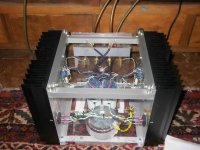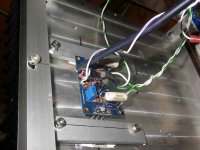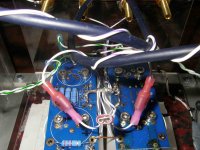Renron, check the current running through the 0.47ohm resistors.
IF that is ok, and it is 1.3amps, then do what someone already said, put ur finger on the Mosfet and see how hot it is getting, if you can't touch it after the amp has been on for a while (better check earlier than that too) then ur not getting proper transfer to the heatsink...
My friend's F5 gets reasonably hot after being on for about 30mins or more, since it takes time for the heat to spread across the rather substantial heatsink...
so, I'm not sure what size heatsink u've got Renron, but maybe a jpeg will tell the tale?
_-_-bear
IF that is ok, and it is 1.3amps, then do what someone already said, put ur finger on the Mosfet and see how hot it is getting, if you can't touch it after the amp has been on for a while (better check earlier than that too) then ur not getting proper transfer to the heatsink...
My friend's F5 gets reasonably hot after being on for about 30mins or more, since it takes time for the heat to spread across the rather substantial heatsink...
so, I'm not sure what size heatsink u've got Renron, but maybe a jpeg will tell the tale?
_-_-bear
Hi Osscar
I dont think you should be worried about temp. i have a Power Follower 99, heatsink temperature is about 90 degree celsius. I have never measured fet's But It should run hot. Enjoy in sound just
regards
Goran
I dont think you should be worried about temp. i have a Power Follower 99, heatsink temperature is about 90 degree celsius. I have never measured fet's But It should run hot. Enjoy in sound just
regards
Goran
Which is the best resistor value to replace the 4.7k thermistor?
In addition in which way we can reach the desired working temperature of the amplifier for less than an hour?
The problem is that I have to wait about 2-3hours to get my amplifier hot!
In addition in which way we can reach the desired working temperature of the amplifier for less than an hour?
The problem is that I have to wait about 2-3hours to get my amplifier hot!
I use large heatsinks!!!
Attachments
Last edited:
You cannot safely heat up the amp much faster just by changing the thermistor, and even if you made the 2.2k smaller and thermistor larger, you would probably not get that much shorter heat up time.
You can heat up the heatsinks with some other heatsource... 😉
btw your output terminal wires should not be wound around the inputs - you may get oscillations this way.
You can heat up the heatsinks with some other heatsource... 😉
btw your output terminal wires should not be wound around the inputs - you may get oscillations this way.
btw your output terminal wires should not be wound around the inputs - you may get oscillations this way.
Its a ground cable!
In my F5 Between heatsink and FET body is a 10-degree difference approx.(heatsink about 40-50; body about 60 - 65-i measured with IR thermometer some time ago) I use the silicone insulation pad which not the best. It is thought to replace the Mica or kapton but I can not pull oneself again for rebuilding 😀
Do I have to worry about it ?
thank you,
regards
Hi Osscar,
I wouldn't worry. I ran my fairchild mosfets at 110C+ for several weeks before installing sil-pads (now 65C/sink 75C). They are still running some months later. One nice thing about the sil-pads is that they don't use/require grease, so less mess.
thermal conductivity W-mK (higher is better)
aluminum 250
copper 380
mica 0.71
silicone grease 0.7+
sil-pad400 0.9
Thickness is an additional factor and I think sil-pad is probably thinner than typical mica/grease combo.
Thanks for the information Alazira and Andrew. Currently I do not change anything - I am enjoying every day sound of F5 with the new(and and pretty cheap) lot's sensitive speakers. Very light sound of the amplifier in spite of its weight 😀 at this time I do not use any preamp - just a CD player line level adjustment from remote control, but the-20dB on sony CDP is not enough - f5 sounds too loud for me sometimes.
It seems that I've joined Papa`s DIY fan club 😎
It seems that I've joined Papa`s DIY fan club 😎
Hi a.wayne,
I did the conclusions based on sounding performance of my F5. I have no signs of audiophile (im use only standard parts - 1% Metal film 0.6W all small resistors and power film 3w resistors and vishay transistors). but the measurements of the my F5 amplifier is well (square wave response, bandwidth etc..),also design is on top (thank you Mr.Pass for sharing it). So it is not sounding bad-its sound so great IMHO. Now I thinking of another DIY Pass amp construction for my brother - maybe Aleph J or F4.
regrads,
oskars
I did the conclusions based on sounding performance of my F5. I have no signs of audiophile (im use only standard parts - 1% Metal film 0.6W all small resistors and power film 3w resistors and vishay transistors). but the measurements of the my F5 amplifier is well (square wave response, bandwidth etc..),also design is on top (thank you Mr.Pass for sharing it). So it is not sounding bad-its sound so great IMHO. Now I thinking of another DIY Pass amp construction for my brother - maybe Aleph J or F4.
regrads,
oskars
prooptiki, I can't tell from the pix which way is up. But if the transformer is down, you might consider putting the F5 board and output devices closer to the bottom of the heatsink.
It may not matter because you have a very large heatsink - but see how hot it gets after about 6 hours of being on, after the heatsink reaches some sort of thermal equilibrium.
Wondering if you milled the backside of those heatsinks or if they came that way?
_-_-bear
It may not matter because you have a very large heatsink - but see how hot it gets after about 6 hours of being on, after the heatsink reaches some sort of thermal equilibrium.
Wondering if you milled the backside of those heatsinks or if they came that way?
_-_-bear
prooptiki, I can't tell from the pix which way is up. But if the transformer is down, you might consider putting the F5 board and output devices closer to the bottom of the heatsink.
It may not matter because you have a very large heatsink - but see how hot it gets after about 6 hours of being on, after the heatsink reaches some sort of thermal equilibrium.
Wondering if you milled the backside of those heatsinks or if they came that way?
_-_-bear
Thanks, I am considering also to add two more channels f5 to the botom, but first I have to find out a good way to make my B1 buffer having two outputs!
I made some changes to the thermistors, now they are on the mosfets!
But still the heatsinks are too big, for about 36hours on power, the amplifier is colder than my cd player!!! I am going to try covering the heatsinks...
The heatsinks came as the are now, 40euros!!
Last edited:
Thanks for the information Alazira and Andrew. Currently I do not change anything - I am enjoying every day sound of F5 with the new(and and pretty cheap) lot's sensitive speakers. Very light sound of the amplifier in spite of its weight 😀 at this time I do not use any preamp - just a CD player line level adjustment from remote control, but the-20dB on sony CDP is not enough - f5 sounds too loud for me sometimes.
It seems that I've joined Papa`s DIY fan club 😎
Hi osscar,
just a thought, but if it plays too loud you could increase R9 or even better reduce R10 (100K trimpot would be good here)🙂
Hi - I have a pair of F5s built using Peter Daniels board - apart from the excellent sound I am getting a rather odd effect. If I touch (or just move my hand near) the heatsinks then the volume drops to nothing for about half a second and the fades back in rapidly.
Weird.😕
Even weirder is that once I have done this and then touch the amp again there is no effect.
Weird.😕
Even weirder is that once I have done this and then touch the amp again there is no effect.
- Home
- Amplifiers
- Pass Labs
- F5 power amplifier


